Yosemite offers stunning stargazing, but you might feel overwhelmed. Where to start? Which spots are best? The vastness of Yosemite’s night sky can leave you uncertain about how to plan your stargazing adventure.
Despite its beauty, stargazing in Yosemite can be challenging. The park’s size and variety of locations mean choices are abundant but not always easy. Without guidance, you could miss the park’s best astronomical experiences.
In this article, I walk you through Yosemite’s top stargazing locations, ideal times, and essential tips. You’ll learn to navigate the night sky easily, making your stargazing journey unforgettable. Let’s unlock the celestial secrets of Yosemite together.
Key Things to Know:
- Glacier Point, Tunnel View, and Sentinel Dome are the best Yosemite stargazing spots.
- Essential gear: star chart, binoculars/telescope, and a red flashlight.
- Optimal times: summer months for clear skies, winter for unique constellations.
- Educational programs: guided tours, astronomy walks, and ranger-led sessions.
Recommended For You
Introduction to Yosemite Stargazing
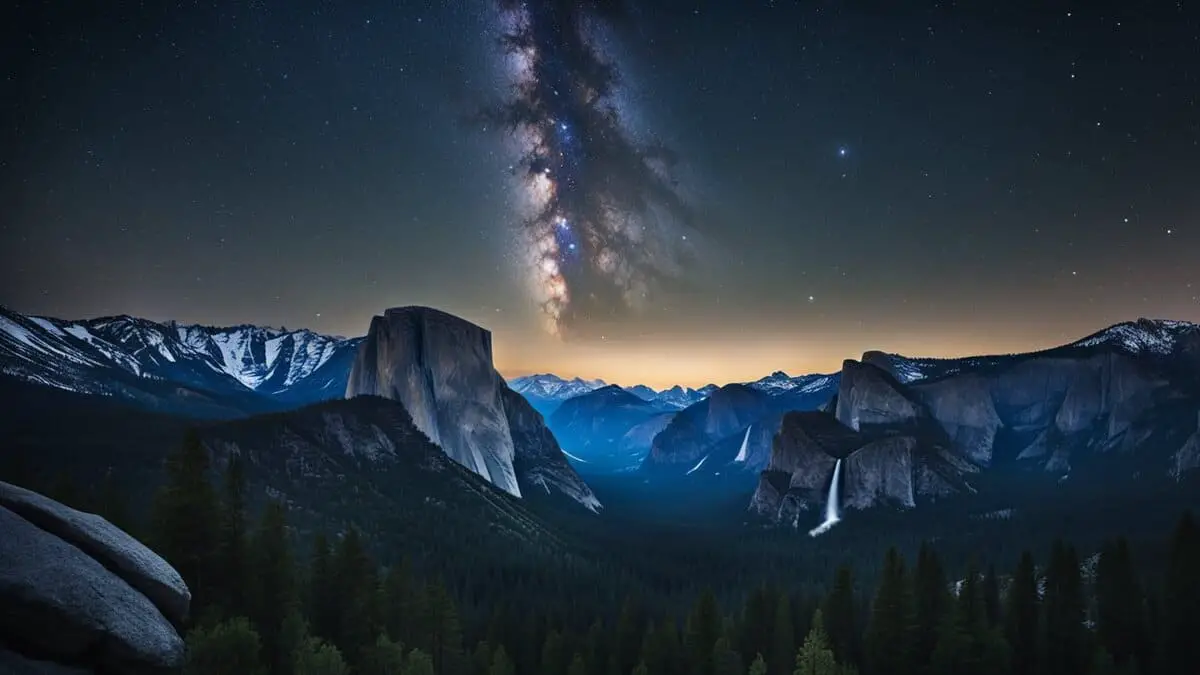
Yosemite National Park offers some of the best stargazing in California for amateur astronomers like you. The park’s dark night sky is perfect for admiring the universe’s wonders. In this section, we’ll introduce you to stargazing in Yosemite and provide helpful tips to make your experience unforgettable.
FREE STARGAZING CHECKLIST
My 5-page Stargazing Checklist will enhance your astronomical observations.
Follow this free checklist to navigate the night sky with confidence, clarity, and a sense of preparedness for a rewarding stargazing experience.

I remember my first night at Yosemite, where the stark contrast from city lights amplified the night sky’s beauty. Some popular spots are Glacier Point and the Yosemite Valley.
When planning your stargazing trip to Yosemite, consider a few essential factors:
- Best time to visit: The summer months, between June and August, are ideal for clear skies and pleasant weather. This time is also during Milky Way Season.
- Equipment: Bring a star chart, binoculars, or a telescope to enhance your night sky viewing.
During my stargazing trips to Yosemite, I’ve gathered some invaluable tips:
- Check the weather forecast before you go, ensuring clear skies and minimal cloud cover.
- Learn the basic constellations for more straightforward navigation of the night sky.
- Avoid using bright white lights, which can diminish your night vision. Bring a red flashlight instead.
I’ve witnessed firsthand how Yosemite’s stargazing appeals to everyone, from curious children to seasoned astronomers. By following these guidelines, you will indeed have an unforgettable night under the stars.
Best Stargazing Spots in Yosemite
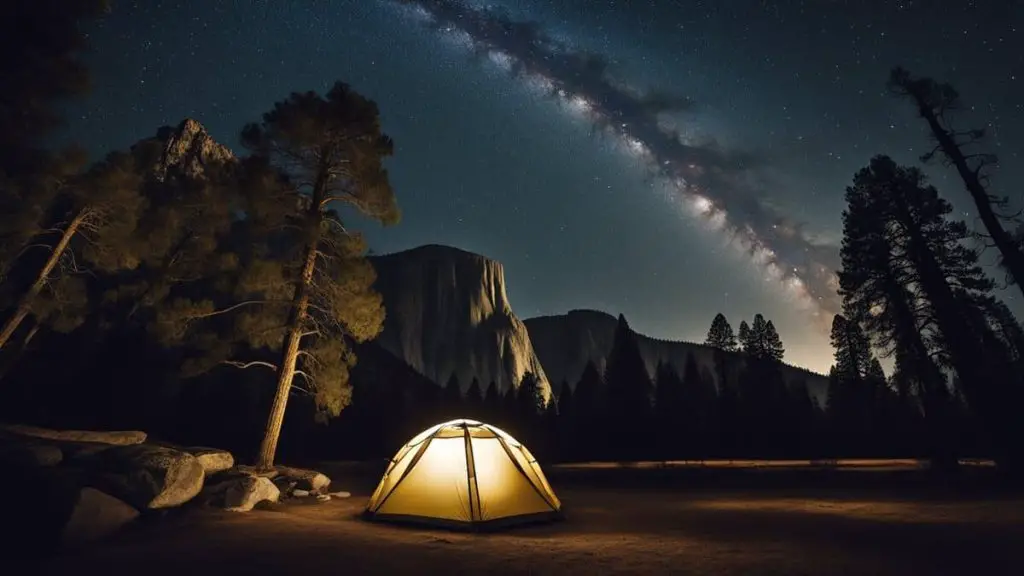
Glacier Point
At Glacier Point, one of the most stunning stargazing spots in Yosemite, I’ve spent countless hours admiring the sky. The location offers unobstructed views of the night sky and is wheelchair accessible. This beautiful spot is perfect for setting up a telescope or taking long-exposure photographs of the starry sky.
Tunnel View
My visits to Tunnel View have always been rewarding, offering a magical stargazing backdrop. With prominent landmarks such as El Capitan and Half Dome, your astronomical experience becomes even more breathtaking. Bring a red flashlight to help you navigate while preserving your night vision.
Sentinel Dome
The time I spent stargazing atop Sentinel Dome, surrounded by a panoramic view of the cosmos, was unforgettable. The top of the dome provides a 360-degree view of the night sky, making your stargazing experience unparalleled. To reach Sentinel Dome, you’ll follow a relatively short hike, so wear comfortable shoes and warm clothing for cooler temperatures at night.
Tuolumne Meadows
I’ve found Tuolumne Meadows to be an exceptional stargazing location, especially for its dark skies and clear views. The altitude and distance from city lights result in dark skies and clear views of the stars.
Here, you can:
- Set up a telescope for detailed viewing of celestial objects
- Use binoculars to explore the sky
- Lay a blanket on the ground and enjoy the view
Yosemite Valley
In my experience, Cooks Meadow in Yosemite Valley is a hidden gem for stargazers. This spot offers unobstructed sky views, which can be rare in the valley due to its shape and tree density.
Other stargazing spots in Yosemite Valley include:
- El Cap Meadow
- Young Lakes
- Olmsted Point
Check weather conditions before heading out to any of these locations, as cloudy skies can negatively impact your stargazing experience.
For even more stargazing in California, read my dedicated article about the Best Stargazing California has to offer.
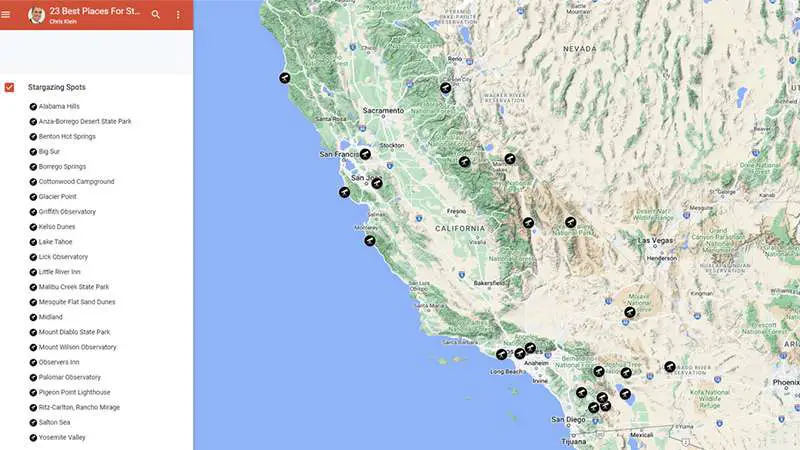
Understanding Astronomy in Yosemite
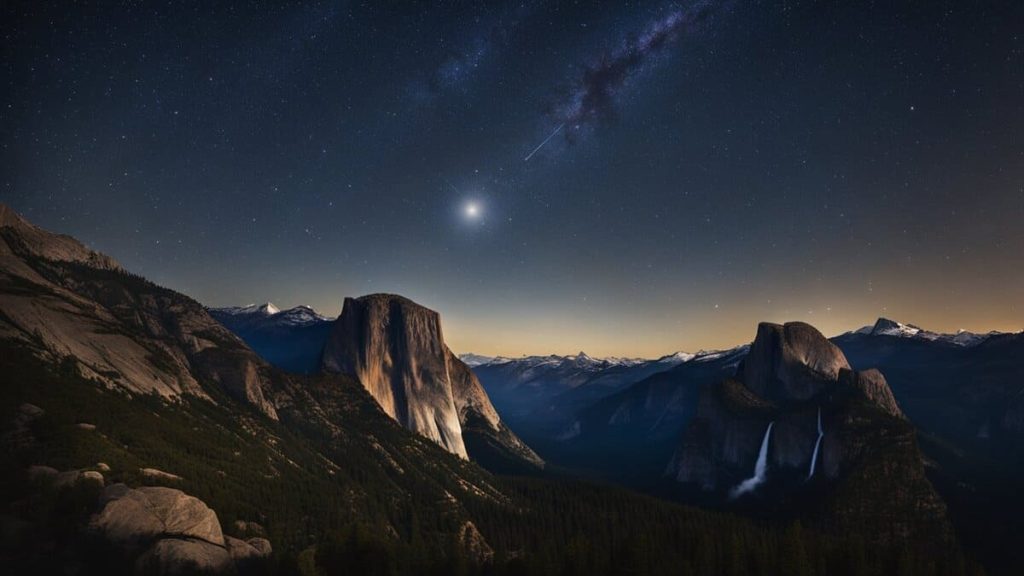
Yosemite National Park offers an incredible natural setting for stargazing, and you will have a chance to appreciate the beauty of the night sky. In this section, we will explore the wonders of astronomy in Yosemite, focusing on three main aspects: constellations and celestial events, planets and star clusters, and galaxies and the Milky Way.
Constellations and Celestial Events
When visiting Yosemite, you can expect to spot numerous constellations that will leave you in awe. The night sky in the park is very dark due to its distance from city lights, allowing constellations to be visible and notable celestial events to be observed.
Some familiar constellations that can be spotted in Yosemite include:
- Orion
- Ursa Major
- Cassiopeia
- Canis Major
In addition to these constellations, you might also witness exciting celestial events such as meteor showers and eclipses. These natural phenomena occur throughout the year and can be an unforgettable sight.
Planets and Star Clusters
Yosemite also offers a chance to observe planets and star clusters with the naked eye or using binoculars. Some planetary neighbors, like Jupiter and Saturn, can be seen shining brightly in the sky.
But if you want a closer look at our solar system’s wonders, you might opt for a stargazing program led by a naturalist. Using laser pointers and telescopes, they can help you identify planets and star clusters, such as the Pleiades and the Beehive Cluster.
Galaxies and the Milky Way
Last but not least, the dark skies of Yosemite provide an excellent opportunity to observe galaxies and the stunning Milky Way.
Thanks to the low levels of light pollution, the majestic Milky Way can be seen cutting across the sky, and you could even spot other galaxies like the Andromeda galaxy through binoculars or telescopes.
Learn more about Light Pollution from the Dark Sky Map California.
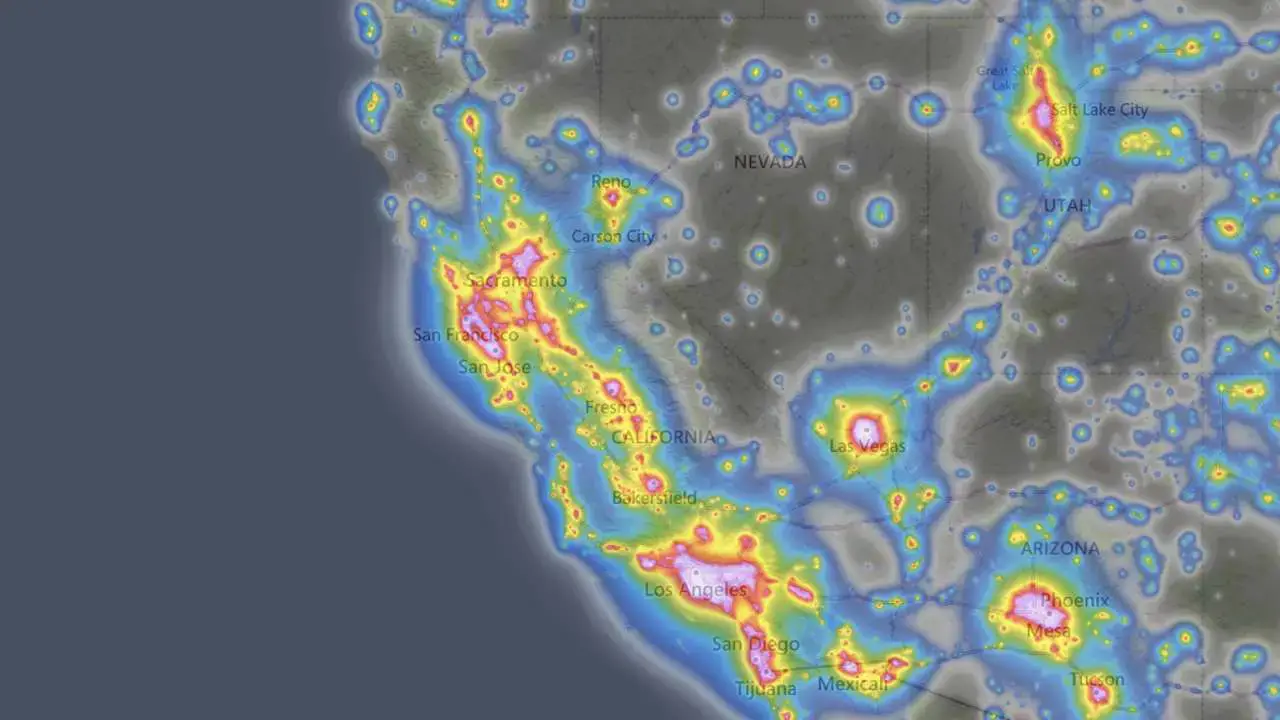
Yosemite National Park offers you a wide variety of astronomical experiences. From constellations to celestial events, planets to star clusters, and the awe-inspiring Milky Way, the night sky above Yosemite is a treasure trove for astronomy enthusiasts and casual stargazers alike.
Stargazing Tours and Programs

Guided Stargazing Tours
Yosemite National Park offers some fantastic stargazing opportunities. One way to experience the night sky is by taking a guided stargazing tour with a professional astronomer.
These tours provide:
- Expert guides: Knowledgeable astronomers who can teach you about constellations, planets, and deep-sky objects
- Telescopes: High-quality telescopes to observe celestial phenomena up close
- Dark skies: Many tours are available in remote locations, far from light pollution
Astronomy Walks
Another option for stargazing in Yosemite is joining an astronomy walk with a Yosemite Conservancy naturalist.
During these walks, you’ll:
- Learn about the park’s night sky and its celestial bodies
- Discover the importance of dark skies and preserve them
- Get hands-on experience using binoculars and telescopes
These astronomy walks are suitable for all experience levels and offer an enjoyable and educational way to spend an evening in the park.
Ranger-Led Programs
I’ve joined several ranger-led stargazing programs in Yosemite and can vouch for their educational and enjoyable nature.
During these programs:
- Park rangers share their knowledge of the night sky and astronomy
- Participation is usually free and doesn’t require any equipment or registration
- Programs often take place at Glacier Point, which provides an excellent location for observing the stars
Remember, while all these stargazing tour options will provide an unforgettable experience, it’s essential to be prepared to spend time outdoors at night. Dress in warm layers, bring a flashlight or headlamp with a red light setting and be ready to enjoy Yosemite’s breathtaking night skies.
Seasonal Stargazing in Yosemite
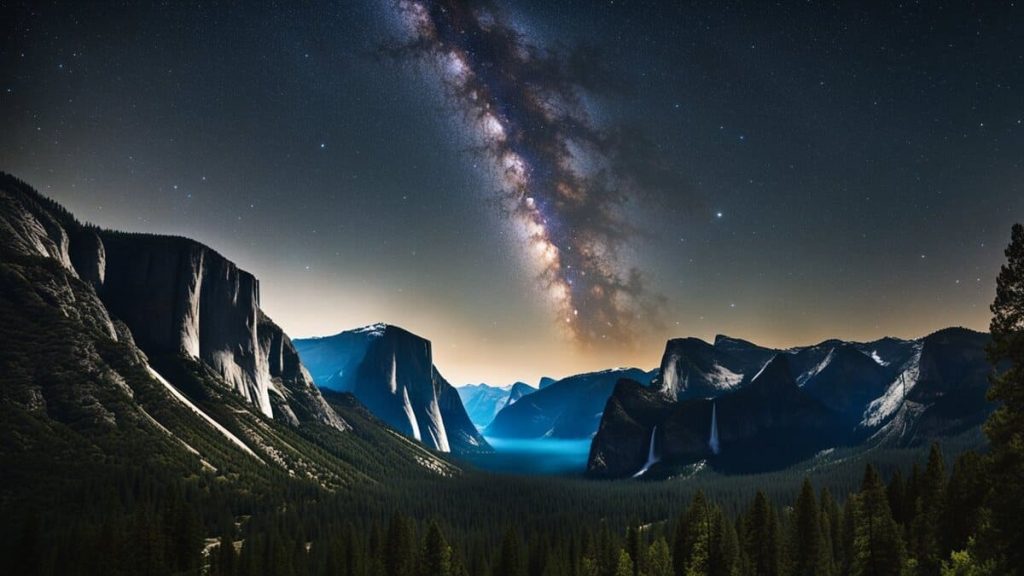
Yosemite National Park offers impressive stargazing opportunities throughout the year. In this section, we’ll explore the unique aspects of summer and winter stargazing in Yosemite, meteor showers, and special astronomical events to look out for.
Summer Skies
Yosemite’s nights are relatively warm in the summer months, making it a great time to watch the stars. The Milky Way stretches across the sky, providing a spectacular view.
Some recommended locations for summer stargazing include:
- Glacier Point
- Yosemite Valley
Remember to:
- Bring a blanket or chair for comfort
- Use red light to preserve your night vision
Winter Stargazing
Yosemite offers crisp mountain air and darker skies during winter due to the earlier sunset. This makes it an ideal time for stargazing. You might even glimpse constellations and celestial objects unseen in the summer months.
Some tips for winter stargazing:
- Dress warmly in multiple layers
- Choose a spot away from artificial lights
- Be patient and let your eyes adjust to the darkness
Meteor Showers and Special Astronomical Events
Yosemite offers incredible opportunities to view meteor showers and other astronomical events throughout the year.
Some notable events to watch for are:
- Perseids Meteor Shower in August
- Geminids Meteor Shower in December
- Partial solar or lunar eclipses, when they occur
To make the most of these events, research the dates, times, and best viewing locations.
Stargazing Tips and Etiquette
Reducing Light Pollution
When stargazing in Yosemite, you want to see the stars as clearly as possible.
To achieve this, you should minimize light pollution:
- Turn off any unnecessary lights, like car headlights or flashlights
- Use red light headlamps to preserve your night vision
- Stay away from bright screens or electronic devices
These simple tips will help maintain a dark sky environment for everyone.
Using Star Charts and Apps
Navigating the night sky can be much easier with the help of a star chart or a stargazing app:
- Choose a star chart or app suited for your location and time of year
- Learn to identify critical constellations, which can help you locate other celestial objects
- Be patient, as it may take time to become comfortable with using these tools
You can spot fascinating celestial objects and impress your fellow stargazers with some practice.
Choosing the Right Equipment
Picking the right equipment can significantly enhance your stargazing experience.
Consider these options:
- Telescopes: Telescopes are great for observing planets and distant celestial objects. When choosing one, consider size, portability, and budget.
- Binoculars: Binoculars are portable and affordable, making them a good option for beginners. Look for binoculars with a large aperture for brighter views of the stars.
- Accessories: Additional gear like star maps, sky glow filters, or folding chairs can make your experience more comfortable and enjoyable.
Finding the right equipment depends on your personal preferences and budget. Invest in what works best for you, and you’ll be well on your way to enjoying unforgettable stargazing experiences in Yosemite.
Photography Under the Stars
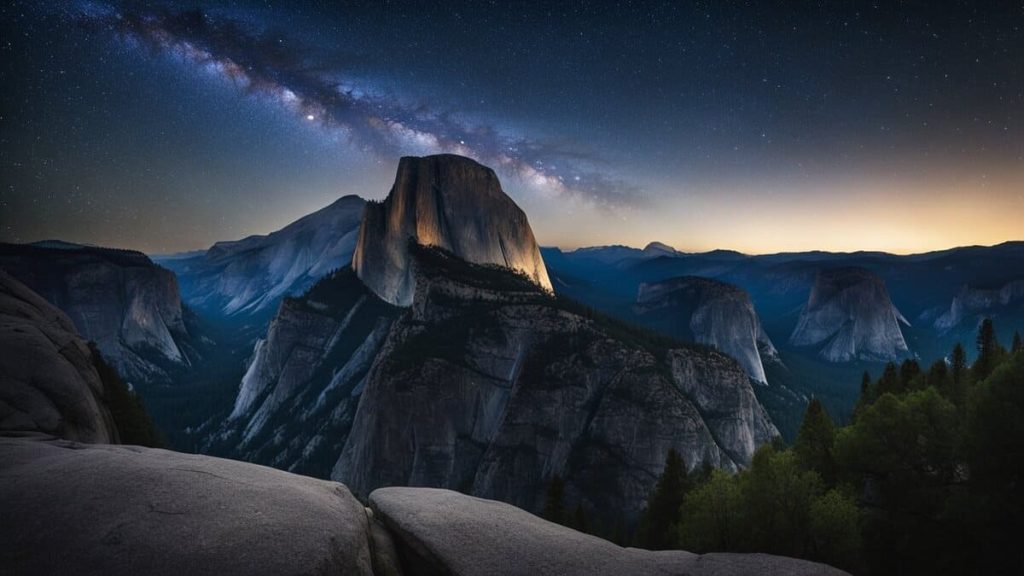
Yosemite National Park is a fantastic place to capture the beauty of the night skies. As an amateur astronomer and photographer, you’ll find ample opportunities for stunning shots of the Milky Way, constellations, and shooting stars.
To make the most of your Yosemite stargazing experience, follow these tips:
- Location: Choose spots with minimal light pollution and unobstructed views. Some recommendations include Glacier Point, Olmstead Point, and Cooks Meadow.
- Timing: Plan your visit during a new moon for the best conditions. Use a moon phase calendar to find the ideal date.
- Equipment: Invest in a sturdy tripod and a fast, wide-angle lens to capture as much light as possible.
- Settings: Experiment with these general settings as a starting point: Aperture: f/2.8 or wider, Shutter speed: 20-30 seconds, ISO: 1600-6400
- Composition: Get creative with your compositions. Aim to include exciting foreground elements or silhouette natural landmarks against the night sky. This will make your photographs stand out.
- Focus: Manually focus on the stars using the live view mode on your camera. Zoom in on a bright star, and adjust the focus ring until it’s sharp.
Remember to dress warmly and bring extra batteries for your camera, as shooting long exposures at night can quickly drain them. With these tips in mind, you’re well-prepared to capture breathtaking photographs of Yosemite’s night skies that you’ll cherish for years.
Accommodations and Amenities
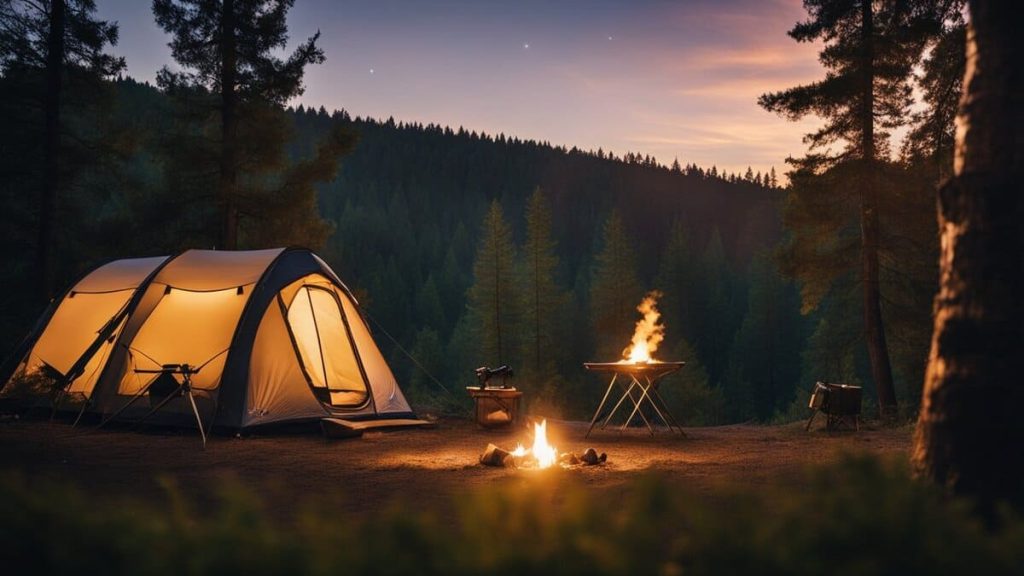
Camping and Lodging
Yosemite National Park offers a variety of camping and lodging options for stargazers. With 13 campgrounds, you can find the perfect spot for your stargazing experience.
Some popular choices include:
- Upper Pines Campground: Located in the heart of Yosemite Valley, this campground provides easy access to Glacier Point for spectacular nighttime views.
- Wawona Campground: Surrounded by a picturesque meadow and the Merced River, Wawona offers serene stargazing opportunities.
Reservations are strongly recommended, as campgrounds fill up quickly, especially during peak season.
Wawona Hotel and Tenaya Lodge
The historic Wawona Hotel and the luxurious Tenaya Lodge provide excellent options for those seeking a more comfortable stay. Both hotels offer amenities such as guided stargazing tours and telescope rentals, allowing you to fully immerse yourself in the Yosemite night sky.
Night-time Access and Facilities
While many of Yosemite’s facilities close at night, some locations remain accessible for stargazing.
Key points of interest include:
- Glacier Point: This popular viewpoint offers a stunning panorama of Yosemite Valley and the high Sierra, making it an ideal spot for night sky observation.
- Tunnel View: With a clear view of El Capitan, Half Dome, and the surrounding Valley, Tunnel View is another excellent location for stargazing.
Remember to dress warmly and bring a flashlight with a red filter to maintain your night vision as you explore these incredible stargazing spots in Yosemite.
Stargazing for All Ages
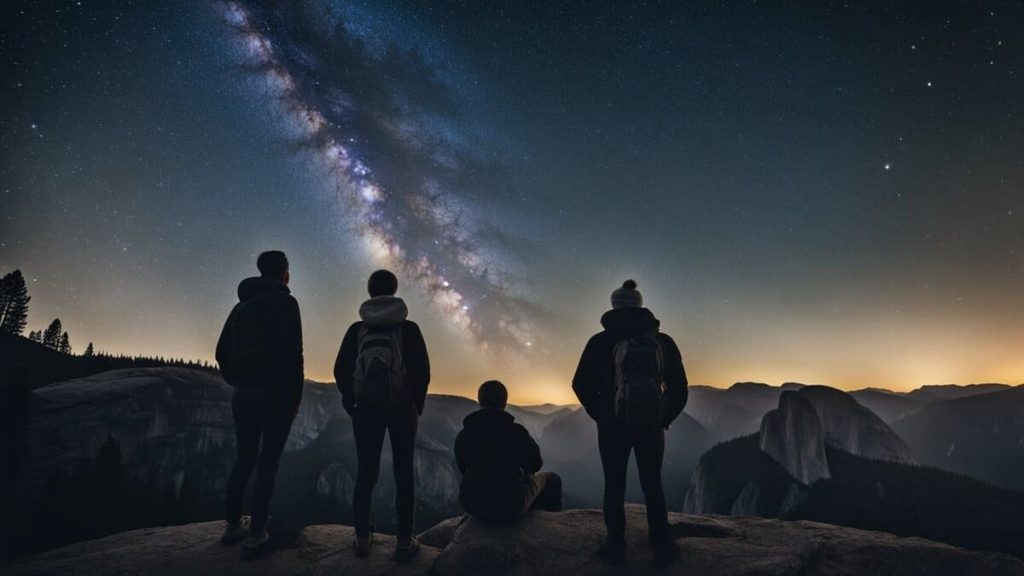
Yosemite National Park offers families and amateur astronomers fantastic opportunities to enjoy stargazing. In this section, you’ll find family-friendly activities and learn about educational outreach for young astronomers.
Family-Friendly Activities
One of the best places to take your family for stargazing is Glacier Point. Yosemite’s dark skies and the higher elevation in Glacier Point offer an unparalleled view of the stars.
Here’s a list of a few family-friendly activities:
- Star Parties: During good nights for stargazing, amateur astronomers commonly set up telescopes, allowing you to gaze at the stars along with fellow enthusiasts.
- Ranger Programs: Yosemite rangers often lead night sky programs to help you explore the night sky and learn about constellations.
- Picnics under the Stars: Prepare a nighttime snack and lay down a blanket to enjoy the beauty of the night sky as a family in a scenic location.
Educational Outreach for Young Astronomers
If you’re looking to spark your child’s interest in astronomy, consider participating in programs offered by Yosemite Conservancy. Their naturalist-led stargazing programs provide an in-depth experience with knowledgeable guides.
Here are some highlights of their program:
- Guided Tours: Join expert naturalists for a guided night sky tour, where they’ll explain interesting phenomena and point out various celestial objects.
- Constellation Spotting: Learn about the mythology and science behind constellations, and practice finding them in the sky with the help of a star chart.
- Telescope Use: Young astronomers can look through a telescope and explore planets, galaxies, and other fascinating cosmic sights.
Participating in these activities allows your family to create lasting memories while enjoying the breathtaking views of Yosemite’s night skies.
The Impact of Stargazing in Yosemite
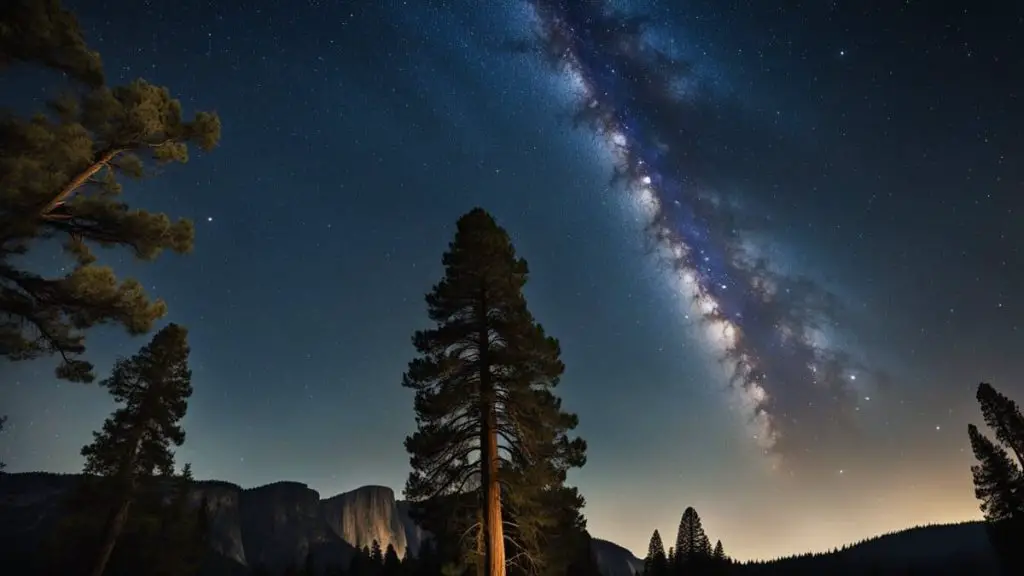
Yosemite National Park, located in the beautiful state of California, provides a world-class stargazing experience for both amateur and seasoned astronomers. The park’s pristine skies and minimal light pollution make it an ideal spot for observing celestial wonders in the Northern Hemisphere.
In this section, I’ll share some critical points on the overall impact of stargazing in Yosemite.
Stargazing in Yosemite has its benefits and impacts on the park and its visitors:
- Environmental: The park’s commitment to preserving its dark skies for stargazing helps conserve the natural habitat of nocturnal animals. Lesser artificial light means a healthier ecosystem overall.
- Educational: Yosemite offers naturalist-led stargazing programs, allowing you to learn about stars, constellations, and planets. These programs encourage kids and adults to develop a deeper appreciation for the night sky and its science.
- Socio-economic: Stargazing attracts diverse visitors to the park, boosting local businesses and the tourism industry. Yosemite National Park generates revenue supporting its conservation and educational efforts by welcoming stargazing enthusiasts.
Here are some practical tips for an unforgettable stargazing experience in Yosemite:
- Choose a clear, moonless night for the best visibility of stars and constellations.
- Bring a Red LED flashlight to preserve your night vision and minimize light pollution.
- Dress warmly, as temperatures in Yosemite can drop quickly after sunset.
Yosemite National Park’s dedication to stargazing benefits its visitors, the environment, and the local community. By planning a stargazing trip to Yosemite, you’re contributing to the ongoing support and preservation of this fantastic natural treasure.
Frequently Asked Questions
What is the Best Way to Prepare for Night-Time Temperatures While Stargazing in Yosemite?
To prepare for night-time temperatures in Yosemite, dress in warm layers and consider bringing a thermal blanket. The park’s altitude can lead to chilly evenings, so staying warm is crucial for a comfortable stargazing experience.
Are there Any Particular Safety Precautions to Take When Stargazing in Yosemite’s Remote Areas?
When stargazing in Yosemite’s remote areas, tell someone your plan and expected return time. Bring a first aid kit, stay on designated trails, and have a reliable emergency communication device. Safety is paramount in these less-traveled locations.
Can I Participate in Stargazing Activities in Yosemite if I Don’t Have My Own Equipment?
Yes, you can participate in stargazing activities in Yosemite even without personal equipment. The park often provides telescopes and binoculars during guided tours and ranger-led programs, making it accessible for everyone to enjoy the night sky.
TL;DR
- Explore Yosemite’s top stargazing spots like Glacier Point and Sentinel Dome for unparalleled night sky views.
- Essential gear includes a star chart, binoculars, a telescope, and a red flashlight to enhance your stargazing experience.
- The best times for stargazing are summer for clear skies and winter for unique constellations.
- Participate in educational activities like guided tours, astronomy walks, and ranger-led programs for a comprehensive experience.
- Yosemite offers night-time facilities and safety advice, ensuring a memorable and secure stargazing adventure.
Your thoughts and questions matter to me! Whether you’re a seasoned stargazer or just starting out, I’d love to hear your experiences or answer any queries you might have about Yosemite’s night sky.
Please share your comments and questions below, and let’s keep the conversation glowing!




